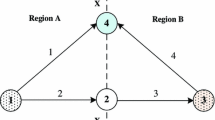Abstract
In this paper, a new approach for solving transhipment model as a transportation model is developed and illustrated. The objective is to expose the transhipment problem to algorithms and methods that are transportation problem (TP) based. The principle of this method consists in merging source nodes with transhipment nodes, through utilization of all possible combination connections, transportation costs are summed up respectively. A numerical example is used to illustrate the approach. The least cost method (LCM) is used to solved the TP resulted from a transformed transhipment problem. Linear programming (LP) models are used as proof of correctness, thus we solve the original transhipment model as an LP problem. This study revealed that solutions from LCM are the same as that of LP formulated from the original transhipment model.




Similar content being viewed by others
References
Adlakha V, Kowalski K, Leo B (2006) Solving transportation problems with mixed constraints. Int J Manag Sci Eng Manag 1:47–52
Anderson DR, Sweeney DJ, Williams TA, Camm TD, Martin K (2013) An introduction to management science: quantitative approaches to decision making, 13th edn. South Western Cengage Learning, Boston
Aneja YP, Nair KPK (1979) Bi-criteria transportation problem. Manag Sci 25:73–79
Arsham H (1992) Postoptimality analysis of the transportational problem. J Oper Res Soc 43:121–139
Bai G (2007) The transportation problem of uncertain freight. J Foshan Univ Nat Sci Ed 25(1):6–10
Burley TA, O’Sullivan G (1991) Operations research, 3rd edn. Macmillan Education Limited, London
Chanas S, Kuchta D (1996) A concept of optimal solution of the transportation problem with fuzzy cost coefficients. Fuzzy Set Syst 82:299–305
Das AOB, Mondal KS, Maiti M (2014) A transportation problem with fuzzy-stochastic costs. Appl Math Model 38(4):1464–1481
Dell’ Amico M, Falavigna S, Lori M (2014) Optimization of a real-world auto-carrier transportation problem. Transp Sci 49(2):402–419
Fegad MR, Jadhav VA, Muley AA (2011) Finding an optimal solution of transportation problem using interval and triangular membership. Eur J Sci Res 60:415–421
Gaurav S, Abbas SH, Gupta VK (2012) Optimum solution of Transportation Problem with the help of Zero Point Method. Int J Eng Res Technol 1(5): 1–6
Gordon HB, Gerald GB, Glenn WG (1977) Design and implementation of large scale primal transhipment algorithms. Manag Sci 24(1):1–34
Gupta A, Khanna S, Puri M (1992) Paradoxical situations in transportation problems. Cahiers du Centre d’Etudes de RecherchéOperationnell 34:37–49
Hammer PL (1969) Time minimization transportation problems. Naval Res Logist Q 16:345–357
Herer YT, Tzur M (2001) The dynamic transshipment problem. Naval Res Logist 48:386–408
Issermann H (1984) Linear bottleneck transportation problem. Asia Pac J Oper Res 1:38–52
Ji P, Chu KF (2002) A dual simplex approach to the transportation problem. Asia Pac J Oper Res 19(1):35–45
Jiang B, Sun M (2007) The model and solution of transportation problem of uncertain demand. Math Teach Res 1:50–52
Jimenez F, Verdegay JL (1999) Solving solid transportation by an evolutionary algorithm based parametric approach. Eur J Oper Res 117:485–510
Kapoor VK (2001) Operations research: techniques for management, vol 7. Sultan Chand and Sons, Delhi
Khurana A (2015) Variants of transportation problem. Eur Transp Res Rev 7(11):1–19
Kundu P, Kar S, Maiti M (2014) Fixed charge transportation problem with type-2 fuzzy variables. Inf Sci 255(1):170–184
Mahapatra DR, Roy SK, Biswal MP (2013) Multi-choice stochastic transportation problem involving extreme value distribution. Appl Math Model 37:2230–2240
Maity G, Roy SK (2014) Solving multi-choice multi-objective transportation problem: a utility function approach. J Uncertain Anal Appl 2:1–20
Martinez-Salazar IA, Molina J, Angel-Isello F, Gomez T, Caballero R (2014) Solving a bi-objective transportation location routing problem by meta-heuristic algorithms. Eur J Oper Res 234(1):25–36
Mathirajan M, Meenakshi B (2004) Experimental analysis for some variants of Vogel’s approximation method. Asia Pac J Oper Res 21(4):447–462
Mohammad KH (2012) Direct methods for finding optimal solution of a transportation problem are not always reliable. Int Refereed J Eng Sci 1(2):46–52
Pandian P, Natarajan G (2010a) A new approach for solving transportation problems with mixed constraints. J Phys Sci 14:53–61
Pandian P, Natarajan G (2010b) A new method for finding an optimal solution for transportation problems. Int J Math Sci Eng Appl 4:59–65
Pandian P, Natarajan G (2011) A new method for solving bottleneck-cost transportation problems. Int Math Forum 6(10):451–460
Putcha C, Putcha AK, Bhuiyan MDRA, Hoque NF (2010) Development of a new optimal method for solution transportation problems. In: Proceedings of the World Congress on Engineering, 3, London, UK
Roy SK, Mahapatra DR, Biswal MP (2013) Multi-choice stochastic transportation problem with exponential distribution. J Uncertain Syst 6(3):200–213
Sharma RRK, Sharma KD (2000) A new dual based procedure for the transportation problem. Eur J Oper Res 122:611–624
Sharma JK, Swarup K (1977) Time minimizing transportation problem. Proc Indian Acad Sci 86:513–518
Szwarc W (1971) Some remarks of the transportation problem. Naval Res Logist Q 18:473–485
Tagaras G (1989) Effects on pooling on the optimization and service levels of two location inventory systems. IEEE Trans 21:250–257
Taha AH (2011) Operations research: an introduction. Pearson Prentice Hall, Upper Saddle River
Yang L, Liu L (2007) Fuzzy fixed charge solid transportation problem and algorithm. Appl Soft Comput 7:879–889
Youness EA (2005) Study on multi-objective transportation problems with fuzzy numbers. Appl Math Comput 166:241–253
Zhi-Feng H, Han H, Xiao-Wei Y (2006) A Novel particle swarm optimization algorithms for solving transportation problem. In: Fifth international conference on machine learning and cybernetics, Dalian, 13–16 Aug
Acknowledgments
The author would like to thank National University of Science and Technology (NUST), Bulawayo, Zimbabwe for providing the facilities and support to conduct and publish this paper, as well as the anonymous reviewers for their helpful comments and suggestions during the development of this paper. I am also indebted to the Editor in chief Dr. Ajit Verma for the role he played.
Author information
Authors and Affiliations
Corresponding author
Rights and permissions
About this article
Cite this article
Tawanda, T. A node merging approach to the transhipment problem. Int J Syst Assur Eng Manag 8 (Suppl 1), 370–378 (2017). https://doi.org/10.1007/s13198-015-0396-9
Received:
Revised:
Published:
Issue Date:
DOI: https://doi.org/10.1007/s13198-015-0396-9




